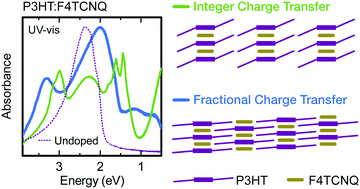当前位置:
X-MOL 学术
›
Mater. Horiz.
›
论文详情
Our official English website, www.x-mol.net, welcomes your feedback! (Note: you will need to create a separate account there.)
Polymorphism controls the degree of charge transfer in a molecularly doped semiconducting polymer
Materials Horizons ( IF 13.3 ) Pub Date : 2018-03-26 , DOI: 10.1039/c8mh00223a Ian E. Jacobs 1, 2, 3, 4 , Camila Cendra 1, 4, 5, 6 , Thomas F. Harrelson 2, 3, 4, 7 , Zaira I. Bedolla Valdez 2, 3, 4, 7 , Roland Faller 2, 3, 4, 7 , Alberto Salleo 1, 4, 5, 6 , Adam J. Moulé 2, 3, 4, 7
Materials Horizons ( IF 13.3 ) Pub Date : 2018-03-26 , DOI: 10.1039/c8mh00223a Ian E. Jacobs 1, 2, 3, 4 , Camila Cendra 1, 4, 5, 6 , Thomas F. Harrelson 2, 3, 4, 7 , Zaira I. Bedolla Valdez 2, 3, 4, 7 , Roland Faller 2, 3, 4, 7 , Alberto Salleo 1, 4, 5, 6 , Adam J. Moulé 2, 3, 4, 7
Affiliation

|
When an organic semiconductor (OSC) is blended with an electron acceptor molecule that can act as a p-type dopant, there should ideally be complete (integer) transfer of charge from the OSC to the dopant. However, some dopant–OSC blends instead form charge transfer complexes (CTCs), characterized by fractional charge transfer (CT) and strong orbital hybridization between the two molecules. Fractional CT doping does not efficiently generate free charge carriers, but it is unclear what conditions lead to incomplete charge transfer. Here we show that by modifying film processing conditions in the semiconductor–dopant couple poly(3-hexylthiophene):2,3,5,6-tetrafluoro-7,7,8,8,-tetracyanoquinodimethane (P3HT:F4TCNQ), we can selectively obtain nearly pure integer or fractional CT phases. Fractional CT films show electrical conductivities approximately 2 orders of magnitude lower than corresponding integer CT films, and remarkably different optical absorption spectra. Grazing incidence wide-angle X-ray diffraction (GIXD) reveals that fractional CT films display an unusually dense and well-ordered crystal structure. These films show lower paracrystallinity and shorter lamellar and π-stacking distances than undoped films processed under similar conditions. Using plane-wave DFT we obtain a structure with unit cell parameters closely matching those observed by GIXD. This first-ever observation of both fractional and integer CT in a single OSC–dopant system demonstrates the importance of structural effects on OSC doping and opens the door to further studies.
中文翻译:

多态性控制分子掺杂半导体聚合物中电荷转移的程度
当有机半导体(OSC)与可以用作p型掺杂剂的电子受体分子混合时,理想情况下应该将电荷从OSC完全(整数)转移到掺杂剂。但是,某些掺杂物-OSC共混物反而形成了电荷转移复合物(CTC),其特征在于分数电荷转移(CT)和两个分子之间的强轨道杂交。分数CT掺杂不能有效地产生自由电荷载流子,但是尚不清楚什么条件会导致电荷转移不完全。在这里,我们表明,通过修改半导体掺杂剂对中的聚(3-己基噻吩):2,3,5,6-四氟-7,7,8,8,-四氰基喹二甲烷(P3HT:F4TCNQ)的膜处理条件,我们可以有选择地获得几乎纯的整数或分数CT相。分数CT膜的电导率比相应的整数CT膜低大约2个数量级,并且光吸收光谱显着不同。掠入射广角X射线衍射(GIXD)显示,分数CT膜显示出异常密集且井井有条的晶体结构。与在类似条件下加工的未掺杂薄膜相比,这些薄膜的结晶度更低,层状和π堆叠距离更短。使用平面波DFT,我们获得了一种结构,其晶胞参数与GIXD观察到的晶胞参数非常匹配。在单个OSC掺杂剂系统中对分数CT和整数CT的首次观察证明了结构效应对OSC掺杂的重要性,并为进一步的研究打开了大门。和明显不同的光吸收光谱。掠入射广角X射线衍射(GIXD)显示,分数CT膜显示出异常密集且井井有条的晶体结构。与在类似条件下加工的未掺杂薄膜相比,这些薄膜的结晶度更低,层状和π堆叠距离更短。使用平面波DFT,我们获得了一种结构,其晶胞参数与GIXD观察到的晶胞参数非常匹配。在单个OSC掺杂剂系统中对分数CT和整数CT的首次观察证明了结构效应对OSC掺杂的重要性,并为进一步的研究打开了大门。和明显不同的光吸收光谱。掠入射广角X射线衍射(GIXD)显示,分数CT膜显示出异常密集且井井有条的晶体结构。与在类似条件下加工的未掺杂薄膜相比,这些薄膜的结晶度更低,层状和π堆叠距离更短。使用平面波DFT,我们获得了一种结构,其晶胞参数与GIXD观察到的晶胞参数非常匹配。在单个OSC掺杂剂系统中对分数CT和整数CT的首次观察证明了结构效应对OSC掺杂的重要性,并为进一步的研究打开了大门。与在类似条件下加工的未掺杂薄膜相比,这些薄膜的结晶度更低,层状和π堆叠距离更短。使用平面波DFT,我们获得了一种结构,其晶胞参数与GIXD观察到的晶胞参数非常匹配。在单个OSC掺杂剂系统中对分数CT和整数CT的首次观察证明了结构效应对OSC掺杂的重要性,并为进一步的研究打开了大门。与在类似条件下加工的未掺杂薄膜相比,这些薄膜的结晶度更低,层状和π堆叠距离更短。使用平面波DFT,我们获得了一种结构,其晶胞参数与GIXD观察到的晶胞参数非常匹配。在单个OSC掺杂剂系统中对分数CT和整数CT的首次观察证明了结构效应对OSC掺杂的重要性,并为进一步的研究打开了大门。
更新日期:2018-07-02
中文翻译:

多态性控制分子掺杂半导体聚合物中电荷转移的程度
当有机半导体(OSC)与可以用作p型掺杂剂的电子受体分子混合时,理想情况下应该将电荷从OSC完全(整数)转移到掺杂剂。但是,某些掺杂物-OSC共混物反而形成了电荷转移复合物(CTC),其特征在于分数电荷转移(CT)和两个分子之间的强轨道杂交。分数CT掺杂不能有效地产生自由电荷载流子,但是尚不清楚什么条件会导致电荷转移不完全。在这里,我们表明,通过修改半导体掺杂剂对中的聚(3-己基噻吩):2,3,5,6-四氟-7,7,8,8,-四氰基喹二甲烷(P3HT:F4TCNQ)的膜处理条件,我们可以有选择地获得几乎纯的整数或分数CT相。分数CT膜的电导率比相应的整数CT膜低大约2个数量级,并且光吸收光谱显着不同。掠入射广角X射线衍射(GIXD)显示,分数CT膜显示出异常密集且井井有条的晶体结构。与在类似条件下加工的未掺杂薄膜相比,这些薄膜的结晶度更低,层状和π堆叠距离更短。使用平面波DFT,我们获得了一种结构,其晶胞参数与GIXD观察到的晶胞参数非常匹配。在单个OSC掺杂剂系统中对分数CT和整数CT的首次观察证明了结构效应对OSC掺杂的重要性,并为进一步的研究打开了大门。和明显不同的光吸收光谱。掠入射广角X射线衍射(GIXD)显示,分数CT膜显示出异常密集且井井有条的晶体结构。与在类似条件下加工的未掺杂薄膜相比,这些薄膜的结晶度更低,层状和π堆叠距离更短。使用平面波DFT,我们获得了一种结构,其晶胞参数与GIXD观察到的晶胞参数非常匹配。在单个OSC掺杂剂系统中对分数CT和整数CT的首次观察证明了结构效应对OSC掺杂的重要性,并为进一步的研究打开了大门。和明显不同的光吸收光谱。掠入射广角X射线衍射(GIXD)显示,分数CT膜显示出异常密集且井井有条的晶体结构。与在类似条件下加工的未掺杂薄膜相比,这些薄膜的结晶度更低,层状和π堆叠距离更短。使用平面波DFT,我们获得了一种结构,其晶胞参数与GIXD观察到的晶胞参数非常匹配。在单个OSC掺杂剂系统中对分数CT和整数CT的首次观察证明了结构效应对OSC掺杂的重要性,并为进一步的研究打开了大门。与在类似条件下加工的未掺杂薄膜相比,这些薄膜的结晶度更低,层状和π堆叠距离更短。使用平面波DFT,我们获得了一种结构,其晶胞参数与GIXD观察到的晶胞参数非常匹配。在单个OSC掺杂剂系统中对分数CT和整数CT的首次观察证明了结构效应对OSC掺杂的重要性,并为进一步的研究打开了大门。与在类似条件下加工的未掺杂薄膜相比,这些薄膜的结晶度更低,层状和π堆叠距离更短。使用平面波DFT,我们获得了一种结构,其晶胞参数与GIXD观察到的晶胞参数非常匹配。在单个OSC掺杂剂系统中对分数CT和整数CT的首次观察证明了结构效应对OSC掺杂的重要性,并为进一步的研究打开了大门。


























 京公网安备 11010802027423号
京公网安备 11010802027423号